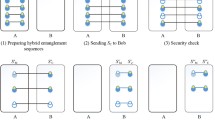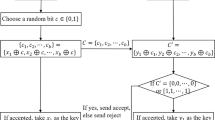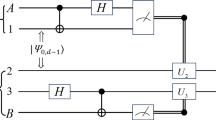Abstract
This article presents an enable-based bidirectional quantum teleportation protocol, leveraging distributed quantum gates with minimal resource requirements. The proposed protocol establishes a two-qubit entangled state as the quantum channel for the transmission of an unknown qubit message between Alice and Bob, enabling bidirectional teleportation. In traditional bidirectional teleportation protocols, both parties serve as senders and receivers, necessitating the utilization of at least two sets of a two-qubit entangled qubit for the channel (totaling four qubits). Contrarily, our contribution controls the functionality of each side via enabling qubits, enabling the implementation of bidirectional teleportation with a mere two-qubit entangled state. Furthermore, the protocol employs simple Z-basis measurements to implement the appropriate unitary operation for obtaining the teleported message. To validate the functionality of the protocol, the quantum circuit is simulated using the Qiskit library, with simulation results on the qasm simulator confirming its effectiveness. The proposed technique possesses wide-ranging applicability and can be incorporated into diverse protocols that employ Toffoli gates as quantum resources.









Similar content being viewed by others
Data and material availability
The codes that support the plots within the paper are publicly available on a Github repository at: https://github.com/paymanprime/enable_BQT_DQG.
References
Ahmadkhaniha, A., Yousef Mafi, P.K.: Enhancing quantum teleportation: an enable-based protocol exploiting distributed quantum gates, (2023)
Ahmadkhaniha, A., Mafi, Y., Kazemikhah, P.: Performance analysis of the partitioned hardware-efficient quantum search algorithm, https://github.com/paymanprime/QSearch_HE.git
Aleksandrowicz, G., Alexander, T., Barkoutsos, P., Bello, L., Ben-Haim, Y., Bucher, D., Cabrera-Hernández, F.J., Carballo-Franquis, J., Chen, A., Chen, C.-F., Chow, J.M., Córcoles-Gonzales, A.D., Cross, A.J., Cross, A., Cruz-Benito, J., Culver, C., González, S.D.L.P., Torre, E.D. La, Ding, D., Dumitrescu, E., Duran, I., Eendebak, P., Everitt, M., Sertage, I.F., Frisch, A., Fuhrer, A., Gambetta, J., Gago, B.G., Gomez-Mosquera, J., Greenberg, D., Hamamura, I., Havlicek, V., Hellmers, J., Herok, Ł., Horii, H., Hu, S., Imamichi, T., Itoko, T., Javadi-Abhari, A., Kanazawa, N., Karazeev, A., Krsulich, K., Liu, P., Luh, Y., Maeng, Y., Marques, M., Martín-Fernández, F.J., McClure, D.T., McKay, D., Meesala, S., Mezzacapo, A., Moll, N., Rodríguez, D.M., Nannicini, G., Nation, P., Ollitrault, P., O’Riordan, L.J., Paik, H., Pérez, J., Phan, A., Pistoia, M., Prutyanov, V., Reuter, M., Rice, J., Davila, A.R., Rudy, R.H.P., Ryu, M., Sathaye, N., Schnabel, C., Schoute, E., Setia, K., Shi, Y., Silva, A., Siraichi, Y., Sivarajah, S., Smolin, J.A., Soeken, M., Takahashi, H., Tavernelli, I., Taylor, C., Taylour, P., Trabing, K., Treinish, M., Turner, W., Vogt-Lee, D., Vuillot, C., Wildstrom, J.A., Wilson, J., Winston, E., Wood, C., Wood, S., Wörner, S., Akhalwaya, I.Y., Zoufal, C.: Qiskit: An Open-source Framework for Quantum Computing, https://doi.org/10.5281/zenodo.2562111, (2019)
Bennett, C.H., Brassard, G., Crépeau, C., Jozsa, R., Peres, A., Wootters, W.K.: Teleporting an unknown quantum state via dual classical and Einstein-Podolsky-Rosen channels. Phys. Rev. Lett. 70, 1895–1899 (1993). https://doi.org/10.1103/PhysRevLett.70.1895
Bouwmeester, D., Pan, J.W., Mattle, K., Eibl, M., Weinfurter, H., Zeilinger, A.: Experimental quantum teleportation. Philos. Trans. r. Soc. a. Math. Phys. Eng. Sci. (1998). https://doi.org/10.1098/rsta.1998.0245
Chen, Y.: Bidirectional quantum controlled teleportation by using a genuine six-qubit entangled state. Int. J. Theor. Phys. 54, 269–272 (2015). https://doi.org/10.1007/s10773-014-2221-7
Choudhury, B.S., Samanta, S.: Asymmetric bidirectional 3 ⇔ 2 qubit teleportation protocol between alice and bob via 9-qubit cluster state. Int. J. Theor. Phys. 56, 3285–3296 (2017). https://doi.org/10.1007/s10773-017-3495-3
Cirac, J.I., Ekert, A.K., Huelga, S.F., Macchiavello, C.: Distributed quantum computation over noisy channels. Phys. Rev. A–At. Mol. Opt. Phys. (1999). https://doi.org/10.1103/PhysRevA.59.4249
Cleve, R., Buhrman, H.: Substituting quantum entanglement for communication. Phys. Rev. A–At. Mol. Opt. Phys. 56, 521 (1997). https://doi.org/10.1103/PhysRevA.56.1201
Duan, Y.J., Zha, X.W., Sun, X.M., Xia, J.F.: Bidirectional quantum controlled teleportation via a maximally seven-qubit entangled state. Int. J. Theor. Phys. 53, 2697–2707 (2014). https://doi.org/10.1007/s10773-014-2065-1
Fang, S.H., Jiang, M.: Bidirectional and asymmetric controlled quantum information transmission via five-qubit brown state. Int. J. Theor. Phys. 56, 1530–1536 (2017). https://doi.org/10.1007/s10773-017-3292-z
Feng, Y.-Y., Zhou, J., Zhang, D.-B., Shi, J.-J.: Parameterized quantum circuits for learning cooperative quantum teleportation. Adv. Quantum Technol. 5, 2200040 (2022). https://doi.org/10.1002/qute.202200040
Fujii, K., Yamamoto, T., Koashi, M., Imoto, N.: A distributed architecture for scalable quantum computation with realistically noisy devices. (2012). https://doi.org/10.48550/arxiv.1202.6588
Grover, L.K.: A fast quantum mechanical algorithm for database search. In: Proceedings of the Twenty-Eighth Annual ACM Symposium on Theory of Computing. pp. 212–219. Association for Computing Machinery, New York, NY, USA (1996)
Grover, L.K.: Quantum Telecomputation. (1997). https://doi.org/10.48550/arxiv.quant-ph/9704012
Kazemikhah, P., Aghababa, H.: Bidirectional quantum teleportation of an arbitrary number of qubits by using four qubit cluster state. Int. J. Theor. Phys. (2021). https://doi.org/10.1007/s10773-020-04704-w
Kazemikhah, P., Tabalvandani, M.B., Yousef Mafi, H.A.: Asymmetric bidirectional controlled quantum teleportation using eight qubit cluster state. Int. J. Theor. Phys. (2022). https://doi.org/10.1007/s10773-022-04995-1
Krojanski, H.G., Suter, D.: Scaling of decoherence in wide NMR quantum registers. Phys. Rev. Lett. (2004). https://doi.org/10.1103/PhysRevLett.93.090501
Li, Y.H., Li, X.L., Sang, M.H., Nie, Y.Y., Wang, Z.S.: Bidirectional controlled quantum teleportation and secure direct communication using five-qubit entangled state. Quantum Inf. Process. 12, 3835–3844 (2013). https://doi.org/10.1007/s11128-013-0638-1
Li, Y.H., Nie, L.P.: Bidirectional controlled teleportation by using a five-qubit composite GHZ-bell state. Int. J. Theor. Phys. 52, 1630–1634 (2013). https://doi.org/10.1007/s10773-013-1484-8
Li, Y.H., Nie, L.P., Li, X.L., Sang, M.H.: Asymmetric Bidirectional Controlled Teleportation by Using Six-qubit Cluster State. Int. J. Theor. Phys. 55, 3008–3016 (2016). https://doi.org/10.1007/s10773-016-2933-y
Mafi, Y., Kazemikhah, P., Ahmadkhaniha, A., Aghababa, H., Kolahdouz, M.: Bidirectional quantum teleportation of an arbitrary number of qubits over a noisy quantum system using $$2n$$Bell states as quantum channel. Opt. Quantum Electron. 54, 568 (2022). https://doi.org/10.1007/s11082-022-03951-x
Mafi, Y., Kazemikhah, P., Ahmadkhaniha, A., Aghababa, H., Kolahdouz, M.: Efficient controlled quantum broadcast protocol using 6n-qubit cluster state in noisy channels. Opt. Quantum Electron. 55, 653 (2023). https://doi.org/10.1007/s11082-023-04928-0
Mahjoory, A., Kazemikhah, P., Aghababa, H., Kolahdouz, M.: Asymmetric tridirectional quantum teleportation using seven-qubit cluster states. Phys. Scr. 98, 85218 (2023). https://doi.org/10.1088/1402-4896/ace38b
Nandi, K., Mazumdar, C.: Quantum teleportation of a two qubit state using GHZ-like state. Int. J. Theor. Phys. 53, 1322–1324 (2014). https://doi.org/10.1007/s10773-013-1928-1
Nickerson, N.H., Li, Y., Benjamin, S.C.: Topological quantum computing with a very noisy network and local error rates approaching one percent. Nat. Commun. 4, 1–5 (2013). https://doi.org/10.1038/ncomms2773
Nie, Y., Li, Y., Liu, J., Sang, M.: Perfect teleportation of an arbitrary three-qubit state by using W-class states. Int. J. Theor. Phys. 50, 3225–3229 (2011)
Nielsen, M.A., Knill, E., Laflamme, R.: Complete quantum teleportation using nuclear magnetic resonance. Nature (1998). https://doi.org/10.1038/23891
Riebe, M., Häffner, H., Roos, C.F., Hänsel, W., Benheim, J., Lancaster, G.P.T., Körber, T.W., Becher, C., Schmidt-Kaler, F., James, D.F.V., Blatt, R.: Deterministic quantum teleportation with atoms. Nature (2004). https://doi.org/10.1038/nature02570
Sadeghi Zadeh, M.S., Houshmand, M., Aghababa, H.: Bidirectional teleportation of a two-qubit state by using eight-qubit entangled state as a quantum channel. Int. J. Theor. Phys. 56, 2101–2112 (2017). https://doi.org/10.1007/s10773-017-3353-3
Sadeghi-Zadeh, M.S., Khorrampanah, M., Houshmand, M., Aghababa, H., Mafi, Y.: n-Bit quantum secret sharing protocol using quantum secure direct communication. Int. J. Theor. Phys. 60, 3744–3759 (2021). https://doi.org/10.1007/s10773-021-04865-2
Sang, M.: huang: bidirectional quantum controlled teleportation by using a seven-qubit entangled state. Int. J. Theor. Phys. 55, 380–383 (2016a). https://doi.org/10.1007/s10773-015-2670-7
Sang, M.: huang: bidirectional quantum teleportation by using five-qubit cluster State. Int. J. Theor. Phys. 55, 1333–1335 (2016b). https://doi.org/10.1007/s10773-015-2774-0
Sarvaghad-Moghaddam, M., Zomorodi, M.: A general protocol for distributed quantum gates. Quantum Inf. Process. 20, 458 (2021). https://doi.org/10.1007/s11128-021-03191-0
Shaterzadeh-Yazdi, Z., Kazemikhah, P.: Multiple silicon dangling-bond charge qubits for quantum computing: a Hilbert-space analysis of the hamiltonian. Phys. Scr. 98, 85101 (2023). https://doi.org/10.1088/1402-4896/ace0e2
Shor, P.W.: Polynomial-time algorithms for prime factorization and discrete logarithms on a quantum computer. SIAM J. Comput. 26, 1484–1509 (1997). https://doi.org/10.1137/S0097539795293172
Tsai, C.W., Hwang, T.: Teleportation of a pure EPR state via GHZ-like state. Int. J. Theor. Phys. 49, 1969–1975 (2010). https://doi.org/10.1007/s10773-010-0382-6
Yan, A.: Bidirectional controlled teleportation via six-qubit cluster state. Int. J. Theor. Phys. 52, 3870–3873 (2013)
Yepez, J.: Type-II quantum computers. Int. J. Mod. Phys. c. 12, 254 (2001). https://doi.org/10.1142/S0129183101002668
Ying, M., Feng, Y.: An algebraic language for distributed quantum computing. IEEE Trans. Comput. (2009). https://doi.org/10.1109/TC.2009.13
Zhang, D., Zha, X.W., Li, W., Yu, Y.: Bidirectional and asymmetric quantum controlled teleportation via maximally eight-qubit entangled state. Quantum Inf. Process. 14, 3835–3844 (2015). https://doi.org/10.1007/s11128-015-1067-0
Zhao, X., Zhao, B., Wang, Z., Song, Z., Wang, X.: Practical distributed quantum information processing with LOCCNet. Npj Quantum Inf. 7, 159 (2021). https://doi.org/10.1038/s41534-021-00496-x
Zhou, R.G., Qian, C., Ian, H.: Bidirectional quantum teleportation of two-qubit state via four-qubit cluster state. Int. J. Theor. Phys. 58, 150–156 (2019). https://doi.org/10.1007/s10773-018-3919-8
Acknowledgements
Not Applicable.
Funding
Not Applicable.
Author information
Authors and Affiliations
Contributions
AA: Implementation, Software, Literature survey, Data Curation Investigation, Writing, Visualization. YM: Implementation, Methodology, Investigation, Analysis, Visualization. PK: Conceptualization, Software, Formal Analysis, Validation, Literature survey, Writing, Data Curation, Visualization. HA: Conceptualization, Project administration, Validation, Resources, Supervision, Writing – Review & Editing. MB: Investigation, Validation, Literature survey, Supervision. MK: Investigation, Validation, Literature survey, Supervision.
Corresponding author
Ethics declarations
Conflict of interest
The authors declare no conflict of interest.
Ethical approval
The authors ethically approve the material of the paper. Authors have been informed and consent regarding the submission of the article. No human/animal has participated in this research.
Additional information
Publisher's Note
Springer Nature remains neutral with regard to jurisdictional claims in published maps and institutional affiliations.
Appendix 1
Appendix 1
Notations and matrix representations of the gates that are used in this paper are shown in Table
4.
Rights and permissions
Springer Nature or its licensor (e.g. a society or other partner) holds exclusive rights to this article under a publishing agreement with the author(s) or other rightsholder(s); author self-archiving of the accepted manuscript version of this article is solely governed by the terms of such publishing agreement and applicable law.
About this article
Cite this article
Ahmadkhaniha, A., Mafi, Y., Kazemikhah, P. et al. Enhancing quantum teleportation: an enable-based protocol exploiting distributed quantum gates. Opt Quant Electron 55, 1079 (2023). https://doi.org/10.1007/s11082-023-05351-1
Received:
Accepted:
Published:
DOI: https://doi.org/10.1007/s11082-023-05351-1




